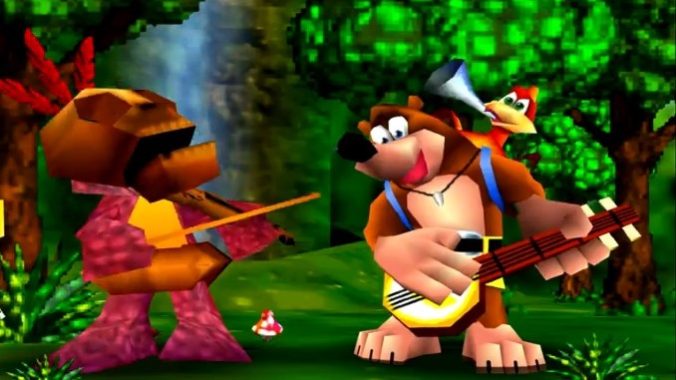
There was a time, not long ago, when not only was it possible for a game studio to outclass Nintendo on their own system, but that the same team—one closely affiliated with the Japanese giant—was doing so on a yearly basis. The success of Rare Ltd, the wacky and weird development wizards from merry ol’ England, is inextricable from the success of Nintendo during the SNES and N64 eras. While not every single game was a hit, genre-defining experiences from Rare were a dime a dozen from the NES on: R.C. Pro-Am, Donkey Kong Country, GoldenEye 007, Diddy Kong Racing, Conker’s Bad Fur Day, and, of course, Banjo-Kazooie.
Banjo-Kazooie is inarguably the golden feather in Rare’s colorfully-plumed cap, retaliating against Nintendo’s own Super Mario 64 with equal parts crass and class. Banjo, the polite do-gooding bear, and Kazooie, his sarcastically-inclined feathered companion, venture into the lair of the evil poet-witch Gruntilda before she can sap Banjo’s sister Tootie of her youthful beauty. Fans have sung the praises of the game since its launch 25 years ago today—the tight controls, whimsical characters, sly writing, and masterful level design make it possibly the best 3D platformer on the system. While all correct answers, this list leaves out what I’d personally consider to be the most important aspect of the game: the music.
Rare knows what to do with its cadre of consummate composers—who but David Wise could’ve written the serene “Aquatic Ambience”—and they couldn’t have chosen a better creative for the game than Grant Kirkhope. Kirkhope joined the company in 1995 after realizing that gigging as a master trumpeter alone wouldn’t help him move out of his mother’s house. His gaming career nearly didn’t work out. In an interview with NME, he discussed how he wanted to resign after a disastrous first day. Rather than using the physical instruments that dominated his livelihood, Kirkhope had to hard-code each note in hexadecimals; such was life composing for the Game Boy. With much help from Wise, he learned how to port the music of others before being given the chance to write his first wholly original score for Banjo-Kazooie. (He also worked with Robin Beanland and Graeme Norgate on GoldenEye, which he wrote the iconic pause music for).
Although I have nothing to go on beyond the two instruments in its name, Banjo-Kazooie feels like an experience crafted entirely around music. Players scour Grunty’s lair for music notes, which serve as the currency d’jeu, while the same polka-based theme follows them around, trying on the different styles and genres found within each level: the electrifyingly jolly jingles of “Freezeezy Peak,” the grimey steam-whistles of “Rusty Bucket Bay,” the seasonally distinct ditties within “Click Clock Woods.” Kirkhope actually did something rather genius here, writing not just variations on the same general theme but working directly with the programmers to have each one fade into one another seamlessly. It’s a process called vertical layering, where all sixteen of the MIDI tracks have instruments programmed to play but those that don’t contribute to the vibe are muted. When players reach a certain trigger, like the landing to Mumbo’s Mountain, the instruments shift fluidly, fading out the marimba to replace it with chants and stomping befitting of the skeletal shaman.
Kirkhope’s aural imagination and playful orchestrations are just as great 25 years later as they were at launch, and I’ve returned to that music often, both for entertainment and background noise. The soundtrack has energized the writing of many essays over the years, particularly chaotic Super Smash Bros Ultimate remixes that accompanied Banjo and Kazooie when they were finally added to the game. Kirkhope himself reorchestrated “Spiral Mountain,” while other composers such as Danganronpa composer Masafumi Takada and Kingdom Hearts legend Yoko Shimomura reinterpreted other tracks, infusing them with electric guitars, full blown choirs, and busting backbeats.
Kirkhope himself got into the re-orchestration mood with the release of Banjo-Kazooie: Re-Jiggyed, a nearly complete reimagining of multiple tracks from the game. If you dreamed of hearing “Spiral Mountain” hummed out on a kazoo, a deeply funky bass version of “Bubblegloop Swamp,” or a guitar shred through “Rusty Bucket Bay,” it’s certainly worth a listen. Even in their energized states, the tracks remain recognizably Kirkhopeian, full of polka swagger and waggish charm. It’s difficult to ruin a fundamentally good piece of music.
With their caricatured collectibles and antiquated controls, Banjo and Kazooie may feel like remnants of a bygone era, but they deserve all the love thrown their way. Rare made a game capable of challenging Mario’s dominance in the very genre the plumber pioneered, on Nintendo’s own hardware, and that’s in no small part due to Kirkhope’s compositions.
In our current age of reboots and reimagining, it’s not impossible to imagine a future where Banjo-Kazooie comes back in some form or another. Microsoft understands the power of the IP, and no one would blame them for finally trying to create a competitor to Mario, which is a battle the Bear and Bird know well. The game has remained in the public consciousness thanks to its availability on the Nintendo Switch Online, and the once hated building mechanics of Banjo-Kazooie: Nuts and Bolts are now lauded in The Legend of Zelda: Tears of the Kingdom. But with Rare so focused on Sea of Thieves and whatever the hell Everwild is, it’s difficult to imagine it being developed with the same love and care. Even the spiritual successor Yooka-Layee—which was developed by ex-Rare employees and had Kirkhope return to compose—couldn’t capture the same magic. It’s something that could only happen on one or tooie occasions.
Mik Deitz is a freelance writer and former Paste intern. They inhale stories in videogames, films, TV and books, and have never finished God of War (2018). Yell at or compliment them on Twitter @dietdeitz.